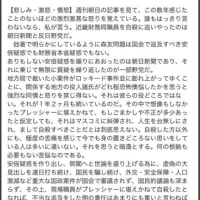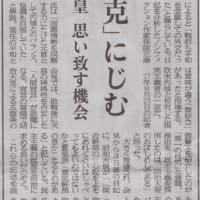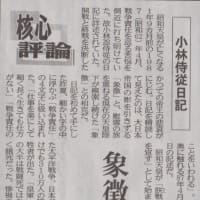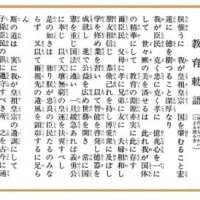NTU@Office BALÉS@tkatsumi06jさんのツイートです。
――#汚染水流出 日本語版と英語版を比較してみてください。これが日本の報道です。|福島第1の汚染地下水、遮水壁上回った可能性高い=原子力規制庁 | Reuters (日本語版)http://jp.reuters.com/article/topNews/idJPTYE97406420130805 … (英語原文和訳版)http://in-the-eyes-of-etranger.blogspot.jp/2013/08/851.html …(2013年8月6日 - 16:21 )――
日本語版は、資料-1、
英語元記事版は、資料-2、
英語原文和訳版、資料-3として、
下に転載しました。
日本版には、
東電という単語に
(注)として
「株価」とあり
株価のページが
リンクさせてあります。
汚染水の問題も
あなたたちにあっては
株価以上に関心ないでしょうと、
言わんばかりです。
“風評”の材料になる
福一の
深刻な状況の記述は
省略されてます。
今のところ、
汚染水の水位が
上がるに応じて株価が下がる
事態は生じてません。
よかったですね――みたいな話に
なっているような印象を受け、ちょっと屈辱的です。
こんな日本向けの報道の
東電に対する親和性、協調性を思うと、
もっと根本的なところで
隠蔽工作に
寄与しているのではないだろうか、
と疑いたくなる。
たとえば、
汚染水の問題が
格納容器内の核燃料を
冷却水の
“漏れ”の扱いであったのが
いつの間にか
地下水の流入問題になっている!
本当のところは、
地下水が
流入したのではなく、
格納容器内を冷却する水が
ひび割れた
容器から漏れ出し
建屋内に溢れ、
地下水となって
海に流れているのが
現状でしょう
(8日発行日刊ゲンダイ記事「原発輸出もナチスの手口」参照)。
残念なのは、
追及する側が
野田前首相のした
“収束宣言”に
拘って、
撤回するのか
と規制委に
詰め寄ってました。
収束したか否かは、
政治の問題ではありません。
科学技術的な
判定の問題ですから、
もともと
野田前首相の
したことに意味が
なかったのです。
その辺りの自覚もない
というのが
とても残念でした
(「BBCニュース 福島第一原発3号機の線量上昇 2013-07-23」参照/リンク)。
■資料-1
「福島第1の汚染地下水、遮水壁上回った可能性高い=原子力規制庁」
ロイター(2013年 08月 5日 21:12 JST)
☆ 記事URL:http://jp.reuters.com/article/topNews/idJPTYE97406420130805
[東京 5日 ロイター] - 原子力規制庁の金城慎司・東京電力福島第1原子力発電所事故対策室長は5日、東電(9501.T: 株価, ニュース, レポート)福島第1原発の放射能汚染地下水について、同社が汚染水の流出を防ぐために設けた地中の遮水壁を上回った可能性があると述べ、「緊急時」との認識を示した。
金城室長はロイターに対し、汚染された地下水は法的基準を超えて海に流出している可能性が高く、東電の地下水くみ上げ計画は一時しのぎにすぎないとの見方を示した。
また、汚染地下水が遮水壁を上回った可能性が高く、地表に上がってくる可能性を否定できないと述べ、現在は「緊急時」と指摘した。
汚染水問題の深刻化を受けて、原子力規制委員会は今月2日、「汚染水対策検討ワーキンググループ」を開き、規制委の更田豊志委員が早急な汚染水汲み上げを指示。東電は会合で、8月後半の汲み上げ開始の意向を示していたが、5日の定例会見で同社の今泉典之・原子力・立地本部長代理は、「今週末くらいから汲み上げを実施したい。検討作業を進めている」と明らかにした。
今のところ、汚染地下水の上昇によってどの程度の脅威が生じるかは不明。2011年3月の東日本大震災に伴う原発事故を受け、日本政府は東電に対し、緊急措置として数万トンの汚染水を太平洋に放出することを認めたが、近隣諸国や地元の漁業関係者から批判を受けた経緯があり、東電は地元の同意なく汚染水を放出しないと約束している。
■資料ー2
EXCLUSIVE-Japan nuclear body says radioactive water at Fukushima an "emergency"
REUTER(Mon Aug 5, 2013 8:00am EDT )
☆ 記事URL:http://www.reuters.com/article/2013/08/05/japan-fukushima-panel-idUSL4N0G61UE20130805
* Fukushima radioactive groundwater could breach surface, regulator says
* Watchdog panel head says Tepco's 'sense of crisis is weak'
* Official says leaks into ocean exceed legal limits
* Tepco apologises, says taking steps to block further leaks into ocean (Adds comments from outside experts, background)
By Antoni Slodkowski and Mari Saito
TOKYO, Aug 5 (Reuters) - Highly radioactive water seeping into the ocean from Japan's crippled Fukushima nuclear plant is creating an "emergency" that the operator is struggling to contain, an official from the country's nuclear watchdog said on Monday.
This contaminated groundwater has breached an underground barrier, is rising toward the surface and is exceeding legal limits of radioactive discharge, Shinji Kinjo, head of a Nuclear Regulatory Authority (NRA) task force, told Reuters.
Countermeasures planned by Tokyo Electric Power Co are only a temporary solution, he said.
Tepco's "sense of crisis is weak," Kinjo said. "This is why you can't just leave it up to Tepco alone" to grapple with the ongoing disaster.
"Right now, we have an emergency," he said.
Tepco has been widely castigated for its failure to prepare for the massive 2011 tsunami and earthquake that devastated its Fukushima plant and lambasted for its inept response to the reactor meltdowns. It has also been accused of covering up shortcomings.
It was not immediately clear how much of a threat the contaminated groundwater could pose. In the early weeks of the disaster, the Japanese government allowed Tepco to dump tens of thousands of tonnes of contaminated water into the Pacific in an emergency move.
The toxic water release was however heavily criticised by neighbouring countries as well as local fishermen and the utility has since promised it would not dump irradiated water without the consent of local townships.
"Until we know the exact density and volume of the water that's flowing out, I honestly can't speculate on the impact on the sea," said Mitsuo Uematsu from the Center for International Collaboration, Atmosphere and Ocean Research Institute at the University of Tokyo.
"We also should check what the levels are like in the sea water. If it's only inside the port and it's not flowing out into the sea, it may not spread as widely as some fear."
NO OTHER OUTLET FOR WATER
Tepco said it is taking various measures to prevent contaminated water from leaking into the bay near the plant. In an e-mailed statement to Reuters, a company spokesman said Tepco deeply apologised to residents in Fukushima prefecture, the surrounding region and the larger public for causing inconveniences, worries and trouble.
The utility pumps out some 400 tonnes a day of groundwater flowing from the hills above the Fukushima Daiichi nuclear plant into the basements of the destroyed buildings, which mixes with highly irradiated water that is used to cool the reactors in a stable state below 100 degrees Celsius.
Tepco is trying to prevent groundwater from reaching the plant by building a "bypass" but recent spikes of radioactive elements in sea water has prompted the utility to reverse months of denials and finally admit that tainted water is reaching the sea.
In a bid to prevent more leaks into the bay of the Pacific Ocean, plant workers created the underground barrier by injecting chemicals to harden the ground along the shoreline of the No. 1 reactor building. But that barrier is only effective in solidifying the ground at least 1.8 meters below the surface.
By breaching the barrier, the water can seep through the shallow areas of earth into the nearby sea. More seriously, it is rising toward the surface - a break of which would accelerate the outflow.
"If you build a wall, of course the water is going to accumulate there. And there is no other way for the water to go but up or sideways and eventually lead to the ocean," said Masashi Goto, a retired Toshiba Corp nuclear engineer who worked on several Tepco plants. "So now, the question is how long do we have?"
Contaminated water could rise to the ground's surface within three weeks, the Asahi Shimbun said on Saturday. Kinjo said the three-week timeline was not based on NRA's calculations but acknowledged that if the water reaches the surface, "it would flow extremely fast."
A Tepco official said on Monday the company plans to start pumping out a further 100 tonnes of groundwater a day around the end of the week.
The regulatory task force overseeing accident measures of the Fukushima Daiichi nuclear power station, which met Friday, "concluded that new measures are needed to stop the water from flowing into the sea that way," Kinjo said.
Tepco said on Friday that a cumulative 20 trillion to 40 trillion becquerels of radioactive tritium had probably leaked into the sea since the disaster. The company said this was within legal limits.
Tritium is far less harmful than cesium and strontium, which have also been released from the plant. Tepco is scheduled to test strontium levels next.
The admission on the long-term tritium leaks, as well as renewed criticism from the regulator, show the precarious state of the $11 billion cleanup and Tepco's challenge to fix a fundamental problem: How to prevent water, tainted with radioactive elements like cesium, from flowing into the ocean. (Additional reporting by Kentaro Hamada; Editing by Edmund Klamann and Raju Gopalakrishnan)
■資料ー3
《和訳》8/5英語版『福島第1の汚染地下水、遮水壁を突破して地表に向かっている=原子力規制庁』
福島第一の汚染水問題は「非常事態」と規制当局者
Watchdog says radioactive water at Fukushima an emergency
ロイター(2013年8月6日 06時45分)
☆ 記事URL:http://in-the-eyes-of-etranger.blogspot.jp/2013/08/851.html
[東京 5日 ロイター]東京電力が汚染水の流出防止に取り組む同社の福島第1原子力発電所で生じた放射能汚染地下水について、原子力規制当局の関係者は5日、事態は「非常事態」にあるとの認識を示した。
原子力規制庁の金城慎司・東京電力福島第1原子力発電所事故対策室長はロイターに対し、法定基準を超えた水量の汚染された地下水が、地中の遮水壁を突破し、地表に向かっているとした上で、東電の地下水くみ上げ計画は一時しのぎにしかならないとの見方を示した。
東電の「危機感は薄い。だから東電のみに任せておけない。現状は非常事態と見る」金城室長はこう語る。
2011年の震災時に生じた大規模な津波に破壊された福島第1原発について、電力事業者の東電は、津波や地震に対する備えと、その後に起きた原子炉のメルトダウンへの対応のずさんさを厳しく非難されてきた。またそうしたずざんな対応を隠蔽してきたとの指摘もある。
現時点では、汚染地下水がどの程度の脅威となるかは明らかにされていない。震災直後、日本政府は東電に対し、緊急措置として数万トンの汚染水を太平洋に放出することを認めていた。しかし、近隣諸国や地元の漁業関係者から批判を受けため、東電には、地元の同意なく汚染水を放出しないと関係者に約束した経緯がある。
「流出している汚染水の正確な濃度と容量がわからないかぎり、海洋への影響について憶測で語ることはできない」東京大学大気海洋研究所・国際連携研究センターの植松光夫所長はこう前置きした上で次のように語った。
「海水におけるそれぞれの程度を計測する必要がある。もし、流出が湾内に限定され、海に流れ出していないのならば、一部が懸念するように汚染が拡大することはないかもしれない」
行き場のない汚染水
東電側は、汚染流出を防ぐべく様々な方策を講じていると主張する。同社広報担当がロイターにメールで寄せた声明によれば、同社は、「福島県の住民のみなさま、周辺地域の住民のみなさま、そして広く日本社会のみなさまに大変な不都合、迷惑と心配をかけていることを心より深くお詫び申し上げている」。
東電では、福島第1原発が置かれる場所の山側から、原発施設内の大破した建物に流入する地下水のうち1日平均400トンの汲み上げ作業を行っている。この地下水は、原子炉を摂氏100度以下の安定温度に維持するために使用される高濃度放射能汚染された冷却水と混じり合う。同社はバイパスを作って地下水の施設流入を防ごうとしてきたが、最近になって海水における放射性物質の濃度が急激に上昇していたとが発覚したため、「汚染水が海に達している」という、同社が数か月間にわたって否定してきた事実を認めざるを得なくなった。
太平洋への汚染水の流出拡大を防ぐ手段として、施設の作業員らは原子炉1号基の建屋が置かれている岸壁近くの土を薬剤で固めて地下に遮水壁を造った。ただし、遮水壁は地下1・8メートルより深い部分にしか造れないためその効果には限界がある。遮水壁を突破した汚染水は、地表の薄い表面を通じて浸透し近場の海に流れ出る。より深刻なのは、水位が地表へ向けて上昇していることだ。地表に達せば、流出はさらに加速する。
「壁を造れば当然そこに水が溜まる。溜まった水は行き場を失い上か横に広がるしかなくなり、最終的には海に出ることになる」
複数の東電の原発で作業した経験を持つ元東芝・原子炉格納容器設計者の後藤政志氏はこう語る。
「だから問題は、あとどのくらい持つかにある」
朝日新聞が3日に伝えたところによれば、「このままのペースで上昇すれば3週間で、水が地面にあふれ出す計算」となる。原子力規制庁の金城室長は、この「3週間」という推測は規制庁の計算によるものではないと前置きした上で、仮に汚染水が地表に達したと仮定した場合、「その流れは大変に速いものとなるだろう」と語る。
東電の関係者は1日、今週末辺りから1日約100トンの単位で地下水のくみ上げを実施する計画だと説明した。これに対し規制委の「汚染水対策検討作業部会」は2日会合を開き「海中への流出を防ぐためには新たな手段を講じる必要があるとの結論を下した」と金城室長は語る。
東電は2日、事故以来、推定で20兆~40兆ベクレルの放射性トリチウム(三重水素)が海に漏れ出したとする試算結果を発表した。同社によれば、これは法律で許容される基準内だという。トリチウムは、東電の原発施設内から放出されたセシウムやストロンチウムに比べ危険性は低いとされる。同社はストロンチウムの流出量についても今後試算する予定だ。
トリチウムが長期にわたり漏れ出していたことを東電が認め、規制当局があらためてこれを厳しく批判したことは、総額110億ドル(約1兆円)の費用がかかる同社の後始末を行う上で、セシウム等の放射性物質で汚染された地下水を海に漏れ出さないようにするという、根本的な課題の解決がいかに危うい状況にあるかを示しているといえる。
――#汚染水流出 日本語版と英語版を比較してみてください。これが日本の報道です。|福島第1の汚染地下水、遮水壁上回った可能性高い=原子力規制庁 | Reuters (日本語版)http://jp.reuters.com/article/topNews/idJPTYE97406420130805 … (英語原文和訳版)http://in-the-eyes-of-etranger.blogspot.jp/2013/08/851.html …(2013年8月6日 - 16:21 )――
日本語版は、資料-1、
英語元記事版は、資料-2、
英語原文和訳版、資料-3として、
下に転載しました。
日本版には、
東電という単語に
(注)として
「株価」とあり
株価のページが
リンクさせてあります。
汚染水の問題も
あなたたちにあっては
株価以上に関心ないでしょうと、
言わんばかりです。
“風評”の材料になる
福一の
深刻な状況の記述は
省略されてます。
今のところ、
汚染水の水位が
上がるに応じて株価が下がる
事態は生じてません。
よかったですね――みたいな話に
なっているような印象を受け、ちょっと屈辱的です。
こんな日本向けの報道の
東電に対する親和性、協調性を思うと、
もっと根本的なところで
隠蔽工作に
寄与しているのではないだろうか、
と疑いたくなる。
たとえば、
汚染水の問題が
格納容器内の核燃料を
冷却水の
“漏れ”の扱いであったのが
いつの間にか
地下水の流入問題になっている!
本当のところは、
地下水が
流入したのではなく、
格納容器内を冷却する水が
ひび割れた
容器から漏れ出し
建屋内に溢れ、
地下水となって
海に流れているのが
現状でしょう
(8日発行日刊ゲンダイ記事「原発輸出もナチスの手口」参照)。
残念なのは、
追及する側が
野田前首相のした
“収束宣言”に
拘って、
撤回するのか
と規制委に
詰め寄ってました。
収束したか否かは、
政治の問題ではありません。
科学技術的な
判定の問題ですから、
もともと
野田前首相の
したことに意味が
なかったのです。
その辺りの自覚もない
というのが
とても残念でした
(「BBCニュース 福島第一原発3号機の線量上昇 2013-07-23」参照/リンク)。
■資料-1
「福島第1の汚染地下水、遮水壁上回った可能性高い=原子力規制庁」
ロイター(2013年 08月 5日 21:12 JST)
☆ 記事URL:http://jp.reuters.com/article/topNews/idJPTYE97406420130805
[東京 5日 ロイター] - 原子力規制庁の金城慎司・東京電力福島第1原子力発電所事故対策室長は5日、東電(9501.T: 株価, ニュース, レポート)福島第1原発の放射能汚染地下水について、同社が汚染水の流出を防ぐために設けた地中の遮水壁を上回った可能性があると述べ、「緊急時」との認識を示した。
金城室長はロイターに対し、汚染された地下水は法的基準を超えて海に流出している可能性が高く、東電の地下水くみ上げ計画は一時しのぎにすぎないとの見方を示した。
また、汚染地下水が遮水壁を上回った可能性が高く、地表に上がってくる可能性を否定できないと述べ、現在は「緊急時」と指摘した。
汚染水問題の深刻化を受けて、原子力規制委員会は今月2日、「汚染水対策検討ワーキンググループ」を開き、規制委の更田豊志委員が早急な汚染水汲み上げを指示。東電は会合で、8月後半の汲み上げ開始の意向を示していたが、5日の定例会見で同社の今泉典之・原子力・立地本部長代理は、「今週末くらいから汲み上げを実施したい。検討作業を進めている」と明らかにした。
今のところ、汚染地下水の上昇によってどの程度の脅威が生じるかは不明。2011年3月の東日本大震災に伴う原発事故を受け、日本政府は東電に対し、緊急措置として数万トンの汚染水を太平洋に放出することを認めたが、近隣諸国や地元の漁業関係者から批判を受けた経緯があり、東電は地元の同意なく汚染水を放出しないと約束している。
■資料ー2
EXCLUSIVE-Japan nuclear body says radioactive water at Fukushima an "emergency"
REUTER(Mon Aug 5, 2013 8:00am EDT )
☆ 記事URL:http://www.reuters.com/article/2013/08/05/japan-fukushima-panel-idUSL4N0G61UE20130805
* Fukushima radioactive groundwater could breach surface, regulator says
* Watchdog panel head says Tepco's 'sense of crisis is weak'
* Official says leaks into ocean exceed legal limits
* Tepco apologises, says taking steps to block further leaks into ocean (Adds comments from outside experts, background)
By Antoni Slodkowski and Mari Saito
TOKYO, Aug 5 (Reuters) - Highly radioactive water seeping into the ocean from Japan's crippled Fukushima nuclear plant is creating an "emergency" that the operator is struggling to contain, an official from the country's nuclear watchdog said on Monday.
This contaminated groundwater has breached an underground barrier, is rising toward the surface and is exceeding legal limits of radioactive discharge, Shinji Kinjo, head of a Nuclear Regulatory Authority (NRA) task force, told Reuters.
Countermeasures planned by Tokyo Electric Power Co are only a temporary solution, he said.
Tepco's "sense of crisis is weak," Kinjo said. "This is why you can't just leave it up to Tepco alone" to grapple with the ongoing disaster.
"Right now, we have an emergency," he said.
Tepco has been widely castigated for its failure to prepare for the massive 2011 tsunami and earthquake that devastated its Fukushima plant and lambasted for its inept response to the reactor meltdowns. It has also been accused of covering up shortcomings.
It was not immediately clear how much of a threat the contaminated groundwater could pose. In the early weeks of the disaster, the Japanese government allowed Tepco to dump tens of thousands of tonnes of contaminated water into the Pacific in an emergency move.
The toxic water release was however heavily criticised by neighbouring countries as well as local fishermen and the utility has since promised it would not dump irradiated water without the consent of local townships.
"Until we know the exact density and volume of the water that's flowing out, I honestly can't speculate on the impact on the sea," said Mitsuo Uematsu from the Center for International Collaboration, Atmosphere and Ocean Research Institute at the University of Tokyo.
"We also should check what the levels are like in the sea water. If it's only inside the port and it's not flowing out into the sea, it may not spread as widely as some fear."
NO OTHER OUTLET FOR WATER
Tepco said it is taking various measures to prevent contaminated water from leaking into the bay near the plant. In an e-mailed statement to Reuters, a company spokesman said Tepco deeply apologised to residents in Fukushima prefecture, the surrounding region and the larger public for causing inconveniences, worries and trouble.
The utility pumps out some 400 tonnes a day of groundwater flowing from the hills above the Fukushima Daiichi nuclear plant into the basements of the destroyed buildings, which mixes with highly irradiated water that is used to cool the reactors in a stable state below 100 degrees Celsius.
Tepco is trying to prevent groundwater from reaching the plant by building a "bypass" but recent spikes of radioactive elements in sea water has prompted the utility to reverse months of denials and finally admit that tainted water is reaching the sea.
In a bid to prevent more leaks into the bay of the Pacific Ocean, plant workers created the underground barrier by injecting chemicals to harden the ground along the shoreline of the No. 1 reactor building. But that barrier is only effective in solidifying the ground at least 1.8 meters below the surface.
By breaching the barrier, the water can seep through the shallow areas of earth into the nearby sea. More seriously, it is rising toward the surface - a break of which would accelerate the outflow.
"If you build a wall, of course the water is going to accumulate there. And there is no other way for the water to go but up or sideways and eventually lead to the ocean," said Masashi Goto, a retired Toshiba Corp nuclear engineer who worked on several Tepco plants. "So now, the question is how long do we have?"
Contaminated water could rise to the ground's surface within three weeks, the Asahi Shimbun said on Saturday. Kinjo said the three-week timeline was not based on NRA's calculations but acknowledged that if the water reaches the surface, "it would flow extremely fast."
A Tepco official said on Monday the company plans to start pumping out a further 100 tonnes of groundwater a day around the end of the week.
The regulatory task force overseeing accident measures of the Fukushima Daiichi nuclear power station, which met Friday, "concluded that new measures are needed to stop the water from flowing into the sea that way," Kinjo said.
Tepco said on Friday that a cumulative 20 trillion to 40 trillion becquerels of radioactive tritium had probably leaked into the sea since the disaster. The company said this was within legal limits.
Tritium is far less harmful than cesium and strontium, which have also been released from the plant. Tepco is scheduled to test strontium levels next.
The admission on the long-term tritium leaks, as well as renewed criticism from the regulator, show the precarious state of the $11 billion cleanup and Tepco's challenge to fix a fundamental problem: How to prevent water, tainted with radioactive elements like cesium, from flowing into the ocean. (Additional reporting by Kentaro Hamada; Editing by Edmund Klamann and Raju Gopalakrishnan)
■資料ー3
《和訳》8/5英語版『福島第1の汚染地下水、遮水壁を突破して地表に向かっている=原子力規制庁』
福島第一の汚染水問題は「非常事態」と規制当局者
Watchdog says radioactive water at Fukushima an emergency
ロイター(2013年8月6日 06時45分)
☆ 記事URL:http://in-the-eyes-of-etranger.blogspot.jp/2013/08/851.html
[東京 5日 ロイター]東京電力が汚染水の流出防止に取り組む同社の福島第1原子力発電所で生じた放射能汚染地下水について、原子力規制当局の関係者は5日、事態は「非常事態」にあるとの認識を示した。
原子力規制庁の金城慎司・東京電力福島第1原子力発電所事故対策室長はロイターに対し、法定基準を超えた水量の汚染された地下水が、地中の遮水壁を突破し、地表に向かっているとした上で、東電の地下水くみ上げ計画は一時しのぎにしかならないとの見方を示した。
東電の「危機感は薄い。だから東電のみに任せておけない。現状は非常事態と見る」金城室長はこう語る。
2011年の震災時に生じた大規模な津波に破壊された福島第1原発について、電力事業者の東電は、津波や地震に対する備えと、その後に起きた原子炉のメルトダウンへの対応のずさんさを厳しく非難されてきた。またそうしたずざんな対応を隠蔽してきたとの指摘もある。
現時点では、汚染地下水がどの程度の脅威となるかは明らかにされていない。震災直後、日本政府は東電に対し、緊急措置として数万トンの汚染水を太平洋に放出することを認めていた。しかし、近隣諸国や地元の漁業関係者から批判を受けため、東電には、地元の同意なく汚染水を放出しないと関係者に約束した経緯がある。
「流出している汚染水の正確な濃度と容量がわからないかぎり、海洋への影響について憶測で語ることはできない」東京大学大気海洋研究所・国際連携研究センターの植松光夫所長はこう前置きした上で次のように語った。
「海水におけるそれぞれの程度を計測する必要がある。もし、流出が湾内に限定され、海に流れ出していないのならば、一部が懸念するように汚染が拡大することはないかもしれない」
行き場のない汚染水
東電側は、汚染流出を防ぐべく様々な方策を講じていると主張する。同社広報担当がロイターにメールで寄せた声明によれば、同社は、「福島県の住民のみなさま、周辺地域の住民のみなさま、そして広く日本社会のみなさまに大変な不都合、迷惑と心配をかけていることを心より深くお詫び申し上げている」。
東電では、福島第1原発が置かれる場所の山側から、原発施設内の大破した建物に流入する地下水のうち1日平均400トンの汲み上げ作業を行っている。この地下水は、原子炉を摂氏100度以下の安定温度に維持するために使用される高濃度放射能汚染された冷却水と混じり合う。同社はバイパスを作って地下水の施設流入を防ごうとしてきたが、最近になって海水における放射性物質の濃度が急激に上昇していたとが発覚したため、「汚染水が海に達している」という、同社が数か月間にわたって否定してきた事実を認めざるを得なくなった。
太平洋への汚染水の流出拡大を防ぐ手段として、施設の作業員らは原子炉1号基の建屋が置かれている岸壁近くの土を薬剤で固めて地下に遮水壁を造った。ただし、遮水壁は地下1・8メートルより深い部分にしか造れないためその効果には限界がある。遮水壁を突破した汚染水は、地表の薄い表面を通じて浸透し近場の海に流れ出る。より深刻なのは、水位が地表へ向けて上昇していることだ。地表に達せば、流出はさらに加速する。
「壁を造れば当然そこに水が溜まる。溜まった水は行き場を失い上か横に広がるしかなくなり、最終的には海に出ることになる」
複数の東電の原発で作業した経験を持つ元東芝・原子炉格納容器設計者の後藤政志氏はこう語る。
「だから問題は、あとどのくらい持つかにある」
朝日新聞が3日に伝えたところによれば、「このままのペースで上昇すれば3週間で、水が地面にあふれ出す計算」となる。原子力規制庁の金城室長は、この「3週間」という推測は規制庁の計算によるものではないと前置きした上で、仮に汚染水が地表に達したと仮定した場合、「その流れは大変に速いものとなるだろう」と語る。
東電の関係者は1日、今週末辺りから1日約100トンの単位で地下水のくみ上げを実施する計画だと説明した。これに対し規制委の「汚染水対策検討作業部会」は2日会合を開き「海中への流出を防ぐためには新たな手段を講じる必要があるとの結論を下した」と金城室長は語る。
東電は2日、事故以来、推定で20兆~40兆ベクレルの放射性トリチウム(三重水素)が海に漏れ出したとする試算結果を発表した。同社によれば、これは法律で許容される基準内だという。トリチウムは、東電の原発施設内から放出されたセシウムやストロンチウムに比べ危険性は低いとされる。同社はストロンチウムの流出量についても今後試算する予定だ。
トリチウムが長期にわたり漏れ出していたことを東電が認め、規制当局があらためてこれを厳しく批判したことは、総額110億ドル(約1兆円)の費用がかかる同社の後始末を行う上で、セシウム等の放射性物質で汚染された地下水を海に漏れ出さないようにするという、根本的な課題の解決がいかに危うい状況にあるかを示しているといえる。




















※コメント投稿者のブログIDはブログ作成者のみに通知されます